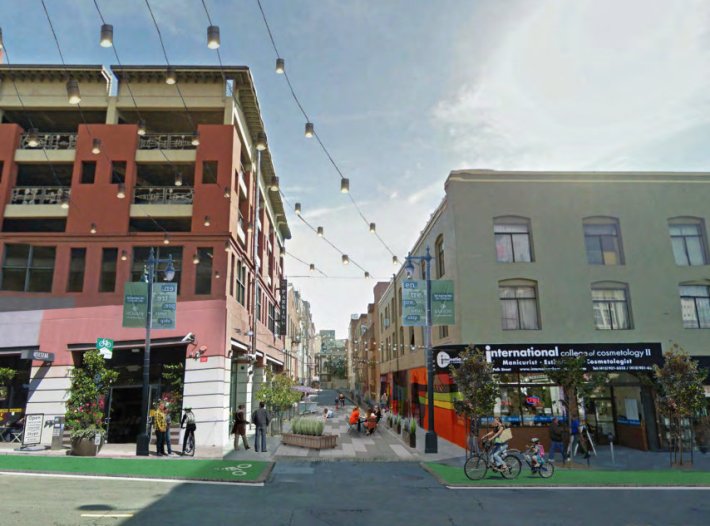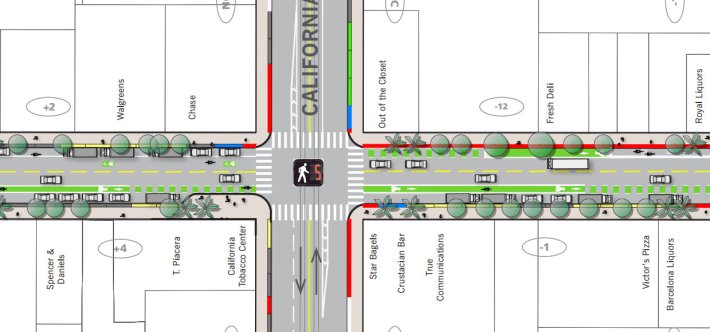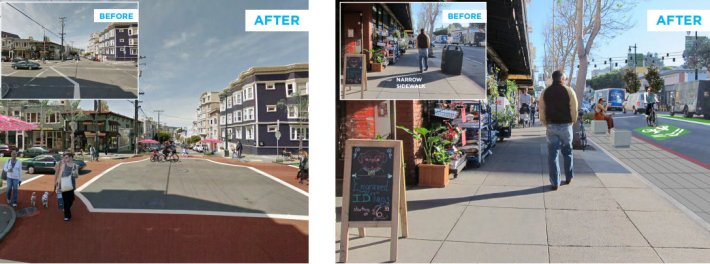
The SFMTA and the Planning Department presented detailed plans for Polk Street at the project's final open house meeting yesterday. The new aspects include specific locations of bulb-outs, dedicated bicycle signals, left turn prohibitions, loading zones, and new trees and landscaping. Plans to improve bicycle infrastructure are still composed of a mix of protected, buffered, conventional, and part-time bike lanes, depending on the stretch and side of the street.
In a blog post, the SF Bicycle Coalition wrote that it is "deeply troubled" that the SFMTA and Supervisor David Chiu have stood by "the lackluster design," in which protected bike lanes were largely cast aside to preserve parking spaces for a vocal minority of merchants.
Noting the inconsistencies between officials' Vision Zero rhetoric and the watered-down proposal to improve safety on Polk, which sees the second highest number of crashes of any corridor in the city, the SFBC announced it is launching a David Chiu/MTA Polk Street Body Count clock, a tracker that will count the number people hurt on Polk going forward.
Luis Montoya, project manager for the SFMTA, characterized the compromised safety plans as an appropriate balance. "I think people see that we've stuck to what we've said the project goals were of improving safety, addressing the specific crash patterns that we see, balancing the needs of the street," he said.

Between McAllister and California Streets, the northbound bike lane will be raised on a curb, with merging zones for drivers turning right at the streets that allow turns in the eastbound direction. The southbound direction will include a buffered, painted bike lane, running to the left of the curb or parked cars, depending on the block. Bicycle riders will be protected from right turning drivers on that side of the street with separate bicycle signal phases and right turn lanes for drivers.
On the northern stretch, between California Street and Broadway, the southbound direction will have a conventional bike lane running between parked cars and moving cars, while northbound will have a part-time bike lane, with parking banned along the curb during morning rush hours. That ban was originally proposed for the northern blocks between Broadway and Union Street, but Montoya said they will retain full-time parking there because parking bans could exacerbate the double-parking problems on that stretch. Instead, he said planners will add a number of loading zones and green "short-term parking" zones to keep stopped vehicles curbside.

"The resounding message from people who bike and walk on Polk Street is that the current design is a recipe for mass confusion and dangerous conflict," the SFBC wrote. "The proposed bikeway zig zags between parked cars and the curb, stops and starts, sometimes completely disappearing for blocks at a time, leaving you hanging while biking and leaving drivers confused and stressed out."
When asked about the SFMTA Board of Directors' request for an option to institute a full-length bike lane as a pilot project, SFMTA staff said they weren't sure what I was referring to.
Meanwhile, Polk's pedestrian realm will get "streetscape enhancements" like greening and pedestrian-scale lighting, which Montoya said encompasses half the project's budget. The full plans are available on the Planning Department's website.
The Polk Street plans must still be approved by the SFMTA Board and the Planning Commission before construction in 2015.






